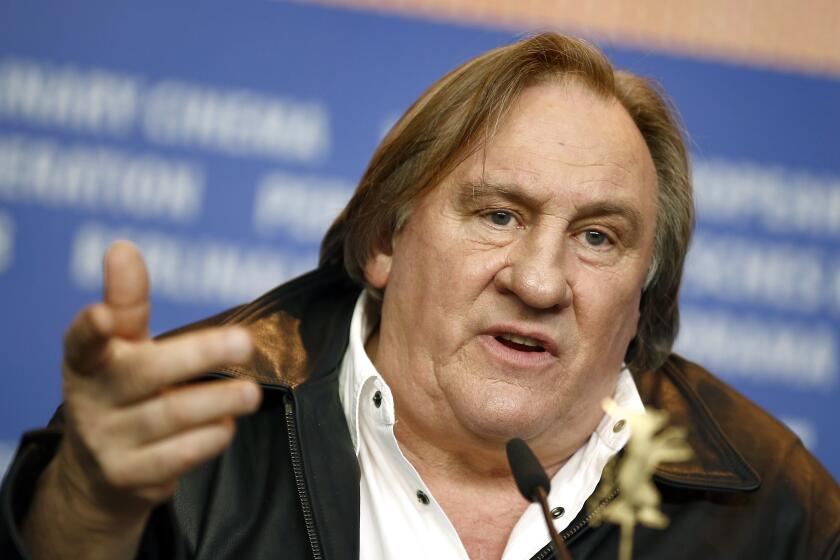Brazil and the pope: an uneasy embrace
The pop-idol priest strides to the altar like the star that he is, a rock band pounding away to his right, cameras flashing to his left and the multitudes pulsating in this cavernous ex-factory that serves as a church.
“Hold the hand of Jesus!” Father Marcelo Rossi, a dynamic giant in a red cassock and billowing white sleeves, proclaims into the cordless mike, urging the faithful to hold hands. “God is tops! God is tops!”
Rossi is the kind of priest who just might be able to save the Roman Catholic Church here. Brazil has more believers than any other country, but the church has been steadily losing members to evangelical denominations.
Rossi is also just the kind of priest that Pope Benedict XVI, who arrives here Wednesday, is likely to frown upon.
Benedict is making his first papal trip to the Americas, home to half the planet’s Catholics, and will face a church replete with competing visions of how to retain the faithful and win back those who have left. The five-day Brazil visit also will serve as an important test of whether a pope seen as a rigid, Europe-focused intellectual, who stresses traditional dogma over creative worship, can reach and influence today’s Latin America.
He has scolded the region’s church in the past, most notably over leftist liberation theology, which emphasizes political activism in the fight for justice for the poor. Catholics here, from bishops gathering to meet with the pontiff to the tens of thousands of worshipers who will crowd around him, are eager to see what direction he will take: Will he embrace the diversity, or will he end up alienating a hopeful but disoriented flock?
For many here, including Rossi, the greatest challenge to Catholicism is the flashy, feel-good magnetism of the Pentecostals and other Protestant evangelical groups, and the best response is to borrow from the competition. Rossi, 39, packs the Sanctuary of the Byzantine Rosary every week. Legions of supporters, especially among the poor, have made his Masses a televised hit.
On his makeshift altar, a poster of a smiling “Bento XVI” looks down as Rossi gyrates and urges enthusiastic worshipers into a hug fest of songs, candles, blessings and tears.
“I was away from the church for 35 years, and Padre Marcelo brought me back,” said Maria dos Santos, 59, one of more than 5,000 who came to see the famous priest’s service on a recent evening.
Outside, vendors hawked “Padre Marcelo” CDs, writings and calendars featuring the priest pictured alongside Christ and the Virgin Mary. Rossi says proceeds from the sales of the CDs go to his parish and Catholic charities.
Ground has been broken on a new chapel that will hold 25,000 people inside and 75,000 outside. Rossi’s website allows online interaction: Followers can send in questions, ask for prayers and make donations.
Rossi’s Mass employs traditional prayers and rituals, but otherwise the scene is reminiscent of a Southern revival meeting. At the service’s boisterous conclusion, Rossi uses a bucket to douse worshipers with holy water.
Eroding membership
He is part of a small but bulging movement of “charismatic” Catholics that has emerged as the traditional church has floundered, losing an estimated 1% of its membership annually in recent decades.
Brazilian Cardinal Claudio Hummes, former archbishop of Sao Paulo and now a senior Vatican official, says Brazil’s Catholic community shrank from 83% of the country’s population in 1991 to 67% in 2005. There is one Catholic priest for every two Protestant ministers, he says.
“How long will Latin America remain a Catholic continent?” Hummes asked. He was speaking in late 2005 during a synod of bishops in Rome. A few days later, the Vatican announced Benedict’s plans to travel to Brazil, home to 124 million Catholics.
The Catholic Charismatic Renewal, as the movement is known here, is only one aspect of a Catholic evangelical drive that proponents believe is halting the exodus from the church.
The charismatic movement has “filled a gap in the church, stressing Catholics’ spiritual needs and talking straight to their hearts about a God of love and mercy,” said Antonio Miguel Kater Filho, founder of the Brazilian Institute of Catholic Marketing, a private research group that consults with the church.
Raves, discos and priests speaking in what they describe as the voices of angels form part of the movement, which arrived in Brazil after the birth of charismatic Catholicism in the United States in the late 1960s. Charismatic groups now flourish in venues such as Sao Paulo’s Pontifical Catholic University, a sprawling campus full of middle-class Catholic youth alienated by traditional services and the Vatican’s strictures on premarital sex and artificial birth control.
“It’s not a new church, it’s not a new religion, it’s the same Catholic Church -- with more passion,” said Father Vandro Pisaneschi, who advises a group of charismatic students on campus. “The church realized that we had to use a different language to reach some of the faithful.”
The German-born Benedict, a stern enforcer of traditional values and practices, seems an unlikely advocate of marketing, Catholic jamborees and priests speaking in tongues.
“The pope says all the time he’s not a very marketing-oriented person,” said Luiz Felipe Ponde, a theologian here who has studied the writings of Benedict, the former Cardinal Joseph Ratzinger. “But nowadays in the modern world, if you’re worried about whether people will follow you, you have to be somewhat market-oriented.”
In addition to its animated services, the Catholic charismatic movement seeks to make church broadcast media more lively, like those of its Pentecostal counterparts.
“It’s very much Latino,” said Father Edward Dougherty, a Jesuit who pioneered the movement in Brazil and helps run a Catholic television station. “Brazilians love Carnival, so we have Carnival retreats. We dance, have a lot of fun.... In the beginning we said we’d be the leaven, we’d be the salt of the food.”
Seen as too ‘Protestant’
Conservative and liberal Catholics alike have decried the movement as undignified, cultish and too “Protestant.” They complain that it comes too close to the “theology of prosperity” -- a pejorative often heaped on Pentecostal sects here that promise material rewards to their contributors.
“Of course there are priests who don’t like Padre Marcelo,” acknowledged Father Juarez Pedro de Castro, archdiocese spokesman here, who himself has cut a CD and hosts several radio and TV call-in programs. But, he added, “the church has always worked with diversity.”
Two popes, Paul VI and John Paul II, acknowledged the validity of the charismatic movement, as has Ratzinger, with reservations.
But how far that notion of diversity goes within the “one catholic and apostolic church” may be an issue this week at the fifth general conference of the bishops of Latin America and the Caribbean in Aparecida, site of Brazil’s most important shrine to the Virgin Mary. Benedict will preside over the meeting of 162 clerics, and it is his main reason for coming to Brazil.
Benedict has already demonstrated unease with the Latin American church, especially with the still potent doctrine of liberation theology, a Marxistinfluenced teaching born of the region’s revolutionary tumult in the 1960s and ‘70s. The church has tried hard to stamp out the movement.
The pope’s decision in March to discipline Father Jon Sobrino, a 69-year-old Spaniard based in El Salvador, sparked considerable criticism in the Americas and has dogged preparations for the bishops conference.
Leonardo Boff, a former Brazilian priest and a proponent of liberation theology who was disciplined by then-Cardinal Ratzinger, told The Times by e-mail that the pope’s action against Sobrino was “a move that is intended to scare us, but has as its principal effect a revival of discussion of that theology.”
The theology of liberation remains alive in Latin America, where a new generation of leftist leaders has emerged and yesterday’s dictatorships have not been forgotten.
In addition to those political realities, Benedict will confront a level of poverty not seen in Europe, and he is being urged to find a relevant way to address the poor, another challenge for the scholarly pope. A recent United Nations study said Latin America suffers the most drastic gap between rich and poor of any region on the planet.
Pope’s emphasis
Benedict signaled his awareness of the crisis, telling nuncios, or papal ambassadors, based in Latin America, in a gathering three months ago, that the church was esteemed for its work in solidarity with the needy.
“Help for the poor and the fight against poverty are and remain a fundamental priority in the life of the churches in Latin America,” he said.
But he gave greater emphasis to other issues, including the importance of “a firm doctrinal and spiritual formation” among the faithful and the need to fight “the proselytism of sects and the growing influence of postmodern hedonistic secularism.”
He also stressed the need to protect the family from moves in some Latin American countries to liberalize abortion and nontraditional marriages. Especially urgent, he said, is to cultivate new priests, who, he reminded his audience, must avoid “the political realm.”
wilkinson@latimes.com
McDonnell reported from Sao Paulo and Wilkinson from Vatican City. Special correspondent Marcelo Soares in Sao Paulo contributed to this report.
More to Read
Start your day right
Sign up for Essential California for news, features and recommendations from the L.A. Times and beyond in your inbox six days a week.
You may occasionally receive promotional content from the Los Angeles Times.







